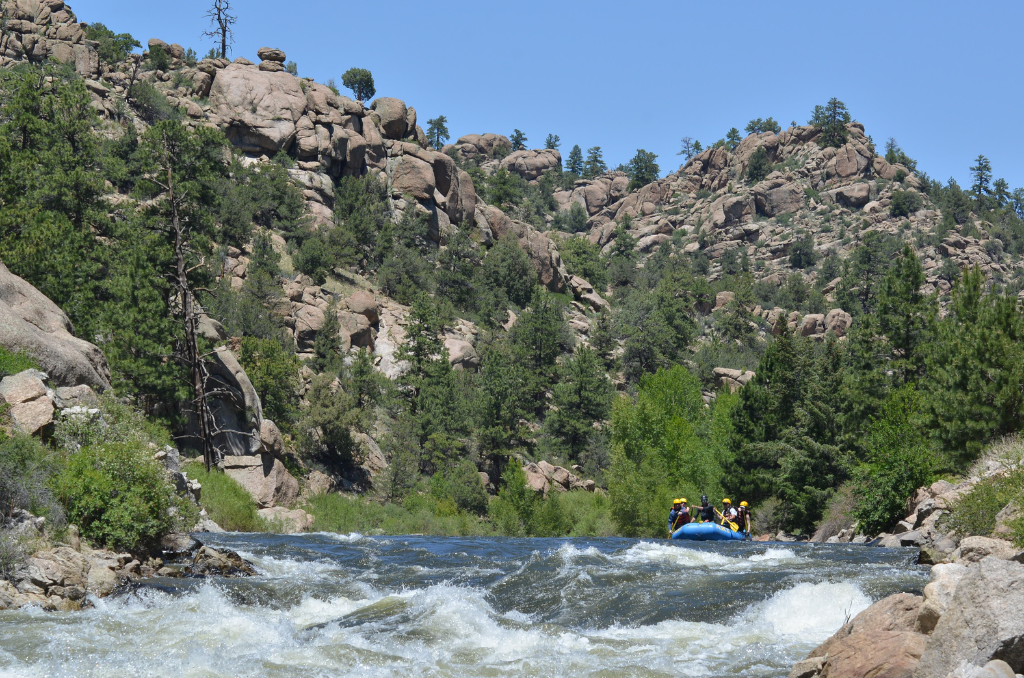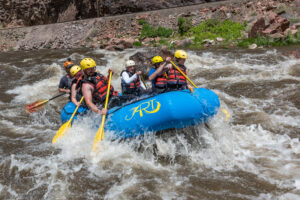Bighorn Sheep Canyon on the Arkansas River is a beautiful and rugged stretch of river located in southern Colorado. Known for its stunning scenery and excellent whitewater rafting, the canyon is a popular destination for outdoor enthusiasts. Here are 5 facts about Bighorn Sheep Canyon that will give you a glimpse into this unique and spectacular place.
Arkansas River Facts – Bighorn Sheep Canyon
Canyon’s Namesake
There are two subspecies of wild sheep in Colorado: the desert bighorn and the rocky mountain bighorn. This particular stretch of the Arkansas River hosts the latter, and if one keeps an eye out, they are destined to see one. While both sexes have horns, males (rams) grow larger ones that become full-curl when they mature. In the fall when the rut enters full swing, rams will battle for females (ewes) by running at competitors and hammering their heads together at speeds up to 40mph. They do this until one of the two submits, hence their name: ram. If you ever get a chance to witness this amazing spectacle, do not pass it up.
Best of the Best
The Arkansas River is officially designated as a Gold Medal Waterway. In order to achieve this status, the fishery must hold a minimum stock of trout of at least 60 pounds per acre with at least a dozen or more 14-inch (or larger) fish per acre. Colorado Parks & Wildlife listed 102 miles of the Arkansas as Gold Medal in 2014. This is the longest Gold Medal stretch in the state and it is in large part due to the healthy watershed in Bighorn Sheep Canyon.
In Good Company
Bighorn Sheep Canyon doesn’t stand alone in glory. One of the most interesting Arkansas River facts is that just upstream from Bighorn Sheep Canyon is the equally impressive Browns Canyon National Monument. In 2015, President Barack Obama granted nearly 22,000 acres of Chaffee County protection under the Antiquities Act. The area’s unique geology, wildlife habitat, and recreation opportunities serve as a model landscape for others of its kind. Want to explore this iconic national monument? Check out ART’s Browns Canyon Rafting trip.
The Hand of Man
While the Arkansas River is the primary driver that shaped Bighorn Sheep Canyon into what it is today, we humans have made an impact as well. Native Americans inhabited the area for thousands of years before the white man, but some of the first European exploits to Bighorn Sheep Canyon are thought to be from mining strikes in the 1870s. The primary minerals excavated at the time included travertine, mica, gypsum, limestone, and manganese. While commercial mining has halted, many historic camps still remain. As do the minerals themselves for you rockhounds out there.
Rafting Paradise
This list wouldn’t be complete without mentioning rafting. In 2021, 256,650 commercial river trips went down the Arkansas River. How about that for an Arkansas River fact? It’s by no stretch of the imagination to say that it’s Colorado’s most popular river to raft. And the section through Bighorn Sheep Canyon is second to none. This part of the river is characterized by intermediate rapids followed by sizeable stretches of flatwater. Anglers love it. The whitewater crowd loves it. Mom and her three kids love it! Bighorn Sheep Canyon is truly a rafter’s paradise—there’s something for everyone.
If you’d love to get on the water but aren’t sure where to start, check out some Colorado whitewater rafting trips from Arkansas River Tours, located just downstream in Cañon City. They offer trips ranging from half-day Arkansas River kayaking trips to multi-day, overnight fly fishing floats. Give ‘em a call and see for yourself why the Arkansas River is the most rafted river in America. We’ll save you a seat!


















